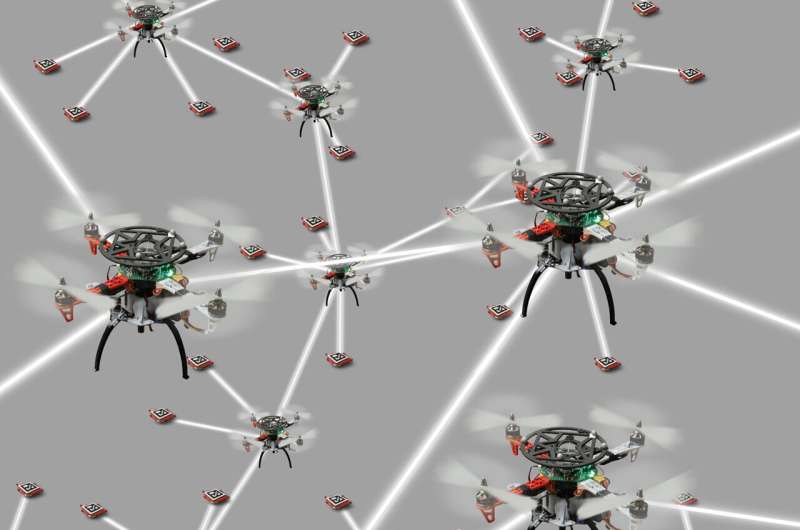November 18, 2024 feature
Editors' notes
This article has been reviewed according to Science X's editorial process and policies. Editors have highlighted the following attributes while ensuring the content's credibility:
fact-checked
peer-reviewed publication
trusted source
proofread
A nervous system-inspired framework to deploy self-organizing robot swarms

The deployment of robot teams could allow humans to complete various real-world tasks faster and more efficiently. For instance, multiple co-operating robots could help to quickly find and rescue survivors of natural disasters or monitor pollution across large geographical areas.
Researchers at Université Libre de Bruxelles (ULB) have developed a new swarm architecture inspired by the human nervous system that could improve co-operation among robots in teams. Their proposed approach, outlined in a paper published in Science Robotics, allows robots to self-organize themselves into sub-swarms, to improve their coordination while they are sensing their environment, moving and planning their next steps towards completing a mission.
"In the past two decades, swarm robotics research has demonstrated a wide range of powerful collective behaviors that do not require any central coordinating entity or process," Dr. Mary Katherine Heinrich, co-first author of the paper and a postdoctoral researcher at the IRIDIA artificial intelligence lab of ULB, told Tech Xplore.
"Despite such progress, robot swarms have still struggled to transition from laboratory experiments to real-world applications. This is because, from the point of view of many application domains, self-organization also has important disadvantages."
Achieving self-organization in robot swarms is a challenging research goal. This is because while desired behaviors occur at the group level, robots are programmed individually, which makes designing swarm behaviors analytically extremely difficult.
"Developing new swarm behaviors is a time-consuming trial-and-error process, and, once new swarm behaviors have been developed, they cannot be easily modified or combined," explained Prof. Marco Dorigo, senior author of the paper and the director of the IRIDIA artificial intelligence lab of ULB.
"In our paper, we address this challenge by combining aspects of centralized control with aspects of self-organized control, to try to harness the benefits of both in one unified system."
The new framework works by constructing and reconstructing self-organizing hierarchies. In other words, it allows robots in a team to self-organize into a dynamic ad-hoc control network, dubbed a self-organizing nervous system (SoNS).
When forming this network, robots temporarily and interchangeably occupy specific positions within a leadership hierarchy, akin to that of the human nervous system. The highest position in this hierarchy is that of the "brain," which guides and supervises group efforts during a mission.
"In a SoNS control network, each robot only communicates with its direct neighbors, to prevent the type of bottleneck that would occur at the communication hub in a fully centralized system," said Dr. Heinrich.
"According to task specifications and system constraints, sensor information can be merged as it is passed upstream, control information can be unmerged as it is passed downstream, and the balance of individual versus collective behaviors can be actively managed."
The SoNS swarm architecture acts as a kind of "middleware" for robots, allowing individual robots to arrange themselves into dynamic hierarchies. In the resulting network, robots can leverage their functionalities as a team to best tackle a given task.
"Using SoNS, robots can coordinate their collective sensing, actuation, and decision-making activities in a locally centralized way, without sacrificing the scalability, flexibility, and fault tolerance benefits normally associated with self-organization," explained Prof. Dorigo.
"In other words, the SoNS architecture effectively allows a robot swarm to be programmed as if it were a single robot, which we believe can greatly improve the transferability of robot swarms from laboratory environments to real-world applications."

Dr. Heinrich, Prof. Dorigo and their colleagues tested their proposed framework in swarm simulations with up to 250 aerial and ground robots and in proof-of-concept experiments with real robots. The results of these tests were highly promising, as their approach could effectively coordinate the actions of numerous robots.
In the future, the team could carry out further tests to assess their framework in a broader range of scenarios. Meanwhile, they plan to improve their proposed swarm architecture further, to facilitate its future deployment on real robots.
"One of the most interesting directions for future research with SoNS is the development of more advanced SoNS brains and more advanced hierarchical computation, for instance enabling online learning or autonomous mission planning capabilities," added Dr. Heinrich and Prof. Dorigo.
More information: Weixu Zhu et al, Self-organizing nervous systems for robot swarms, Science Robotics (2024). DOI: 10.1126/scirobotics.adl5161.
Journal information: Science Robotics
© 2024 Science X Network
Citation: A nervous system-inspired framework to deploy self-organizing robot swarms (2024, November 18) retrieved 18 November 2024 from https://techxplore.com/news/2024-11-nervous-framework-deploy-robot-swarms.html This document is subject to copyright. Apart from any fair dealing for the purpose of private study or research, no part may be reproduced without the written permission. The content is provided for information purposes only.
Explore further
How do robots collaborate to achieve consensus? 63 shares
Feedback to editors









